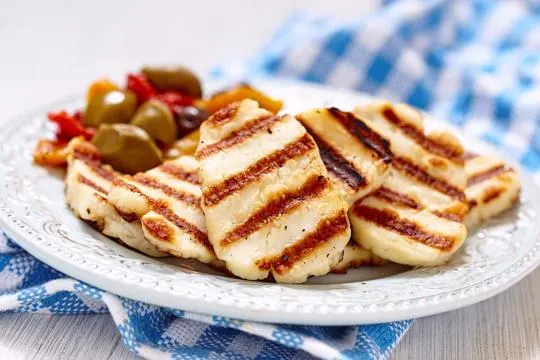Summary of key points
The main difference between bread cheese and halloumi cheese lies in their origin and texture. Bread cheese, also known as juustoleipa, is a Finnish cheese that has a firm and squeaky texture when heated. Halloumi, on the other hand, is a Cypriot cheese with a similar texture but comes from cow, sheep, or goat milk.
In terms of taste, both cheeses have a mild and slightly salty flavor. However, halloumi has a more tangy and savory taste compared to the buttery flavor of bread cheese.
Another distinction is their versatility in cooking. Both can be grilled or pan-fried without melting, making them popular choices for sandwiches or as meat substitutes.
Whether you’re trying out different cheese recipes or looking for a new cheese to add to your charcuterie board, both bread cheese and halloumi offer unique textures and flavors that are sure to please. Just be sure to check for any lactose intolerance or other dietary restrictions before indulging in these delicious cheeses.
Ever stood in the cheese aisle, puzzled by the array of options? We’ve all been there.
Today, we’re tackling two big cheeses: Bread Cheese and Halloumi. You might think, “Cheese is cheese, right?” Wrong.
Each has its own vibe. We dove deep into the cheese world to bring you the scoop. First off, origins matter. Halloumi hails from Cyprus, a heavyweight in grilling circles. Bread Cheese, or ‘Juustoleipa’ if you’re fancy, comes from Finland, with a softer story.
Our cheese battles are legendary in my house. Spoiler: there’s never a clear winner. More cheese, please!
Get ready to be the cheese whisperer at your next dinner party.
What is Bread Cheese?

Bread cheese, also known as juustoleipä or leipäjuusto, comes from Finland.
It has a unique texture and flavour.
It’s made from a mix of cow’s milk and either goat or reindeer milk.
This cheese is cooked specially, and has a squeaky texture.
An interesting feature of bread cheese is that it doesn’t melt at high temperatures.
So you can fry or grill it and it’ll stay in shape.
The outside gets crispy, while the inside stays gooey and warm.
Its salty taste goes well with sweet condiments, like lingonberry jam or honey.
Bread cheese has some nutritional benefits too.
It’s packed with protein and calcium.
These are important for keeping your muscles healthy and your bones strong.
The mix of different milks also adds to its flavour.
All in all, bread cheese is a delicious option for those seeking something different.
Its texture and flavour make it worth trying.
You can eat it alone or add it to dishes.
Either way, it’ll give your meal a tasty kick.
What is Halloumi Cheese?

Halloumi is a cheese from Cyprus.
It has a special texture and is useful in many dishes.
It’s made of goat’s and sheep’s milk.
The outside is firm, but the inside is soft and chewy.
Halloumi is popular in Mediterranean cuisine.
It stays firm when cooked – grilled or fried.
It has a salty flavor that goes well with sweet and savory ingredients.
It won’t melt easily, so it holds its shape while being cooked.
Enjoy it plain or in salads, sandwiches, and desserts.
Halloumi always brings a burst of flavor and texture.
Differences Between Bread Cheese and Halloumi Cheese

Bread cheese and halloumi, though similar, have distinct differences.
Both are known for their firm texture and heat-resistant qualities.
Origin and Cultural Background
Bread cheese and halloumi are unique in their origins and cultural backgrounds.
Bread cheese, also known as juustoleipä or leipäjuusto, has been a traditional staple for the Sami people in Northern Europe, particularly in Finland, Sweden, Norway, and Russia.
It is made with reindeer milk and cooked over an open fire, and has been sustaining the Sami people for centuries, holding deep cultural significance.
Halloumi, on the other hand, is a cheese from Cyprus that has been part of the Cypriot cuisine for hundreds of years, linked to the island’s agricultural heritage.
It is made with sheep’s milk and goat’s milk, and is characterized by its texture that allows it to be grilled without melting.
It has gained popularity worldwide due to its versatility in cooking.
Although both cheeses are cookable, their cultural backgrounds make them different.
Bread cheese represents the history and traditions of the Sami people, while halloumi reflects the culinary heritage of Cyprus.
Ingredients and Cheese Making Process
Cheese-making needs special ingredients and a precise process.
The kind of cheese produced depends on these.
Bread cheese and halloumi have key differences when it comes to ingredients and production.
Bread cheese is made of cow’s milk while halloumi usually has a blend of sheep’s and goat’s milk.
Rennet is essential for both.
But bread cheese involves curdling the milk, extracting whey, then baking or frying.
Halloumi, however, requires a more complex method.
After curdling, the mixture is heated to eliminate liquid.
Then, it is molded into blocks and brined.
To finish, it can be grilled or pan-fried.
Bread cheese does not melt when heated due to its low acid and special technique.
Halloumi, on the other hand, can take more heat due to its higher acidity and salt.
These dissimilarities in ingredients and production lead to distinct textures, flavors, and uses of bread cheese and halloumi.
Whether savored fried for that crunchy outer layer like bread cheese or grilled for that irresistible charred taste like halloumi, each cheese offers an exclusive experience for food lovers around the world.
Texture and Melting Point
Texture and melting point are major factors in distinguishing between bread cheese and halloumi.
Bread cheese has a firm, elastic texture.
Halloumi is softer but still holds its shape when cooked.
Bread cheese has a higher melting point than halloumi, which makes it suitable for grilling or frying.
On the other hand, halloumi has a lower melting point, giving it a creamy, gooey texture when heated.
These differences in texture and melting point create unique culinary experiences.
Bread cheese’s firmer texture can be used as a sandwich filling or eaten alone.
Halloumi’s soft texture is great for grilling or pan-frying, creating a melted center with crunchy edges.
The choice depends on personal preference and the desired outcome of the dish.
Flavor and Taste
Taste and flavor are vital for distinguishing bread cheese and halloumi.
Both have unique flavors, yet there are some clear distinctions.
Bread cheese has a creamy flavor with subtle sweet notes.
It has a smooth texture that melts in your mouth.
On the other hand, halloumi has a tangy taste with a salty undertone.
When raw, its texture is firm and squeaky, but it becomes soft and gooey when grilled or pan-fried.
Apart from their basic flavors, variations come from ingredients and preparation.
Bread cheese is usually made from cow’s milk and has a slightly nutty flavor, whereas halloumi is often made from sheep’s or goat’s milk, giving it a more robust, earthy taste.
Cooking techniques also contribute to these cheeses’ unique flavors.
Bread cheese is usually baked or fried, resulting in a crispy outer layer and tender inside.
Halloumi, on the other hand, is typically grilled or pan-fried so it acquires a golden brown crust while keeping its chewy texture.
In conclusion, bread cheese and halloumi have similarities in being delicious and savory, yet they differ in flavor.
So, whether you prefer the creamy sweetness of bread cheese or the tangy saltiness of halloumi, both provide amazing tastes worth trying.
Culinary Uses and Cooking Methods
Bread cheese and halloumi are two distinct types of cheese with unique flavors and textures.
They stay in shape when cooked, providing a crispy exterior and creamy interior.
Bread cheese’s mild, salty taste makes it great for sandwiches with any combination of veggies, meats, and preserves.
Halloumi works as a vegetarian protein substitute and adds depth to salads.
Both are also delicious on their own – warm bread cheese with honey or maple syrup, and halloumi with lemon.
These cheeses offer plenty of options for delicious meals.
Similarities Between Bread Cheese and Halloumi Cheese

Bread cheese and Halloumi have many similarities.
Both are great for grilling or frying due to a high melting point.
They also have a special taste and texture.
But there are differences too.
Bread cheese is from Finland and Halloumi from Cyprus.
Plus, Halloumi is made with a mix of goat and sheep milk, while bread cheese mainly uses cow milk.
These small variations give them different flavors.
So, if you crave something delicious, go for either bread cheese or Halloumi – both are sure to please.
Where to Find Bread Cheese and Halloumi?
Bread cheese and halloumi are both yummy.
They have special flavors that make them stand out.
If you’re looking for them, there’s no need to worry.
You can find these cheeses in many places.
At cheese shops or gourmet stores, you’ll often find a wide selection.
Supermarkets may also carry them, usually in the specialty or international sections.
Online retailers let you order cheese right to your door.
Check out different brands and reviews before you buy.
This is great if you don’t have access to specialty stores.
Restaurants now feature bread cheese and halloumi on their menus.
A brunch spot or Mediterranean eatery often serves tasty dishes with these cheeses.
Try grilled halloumi salads or bread cheese appetizers.
Conclusion
In conclusion, it’s clear that with variations in production and uses for bread cheese and halloumi, there exist a distinguishing factor that sets the two apart.
Knowing the difference between them can help enhance your culinary experience or guide you towards the best choice of cheese for your dish.
With its properties both as firm and flexible to fry yet able to hold it’s shape when boiled or grilled, halloumi is an excellent addition to many salads, sides, and platters.
For those looking for something more authentic in flavor, bread cheese is a good way to go as a common ingredient used by various cultures.
So if you’re still trying to decide which one is right for you, be sure to consider their respective attributes before preparing your dish so you can get the most out of your experience.

Leave a comment